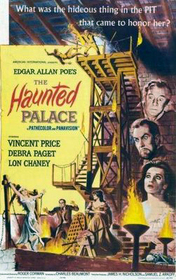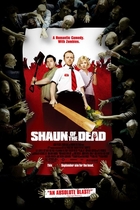Our editor-in-chief Nate Yapp is proud to have contributed to the new book Hidden Horror: A Celebration of 101 Underrated and Overlooked Fright Flicks, edited by Aaron Christensen. Another contributors include Anthony Timpone, B.J. Colangelo, Dave Alexander, Classic-Horror.com's own Robert C. Ring and John W. Bowen. Pick up a copy today from Amazon.com!
The Haunted Palace (1963)
Roger Corman, despite his myriad of other films, will always be remembered for the Poe Cycle of the 1960s. Spooky stories, opulent sets, and Vincent Price's languid mannerisms – the Gothic beauty of Edgar Allan Poe, all shot in 2.35:1 with a generous use of deep focus. However, like any good family, even the Poe Cycle has its black sheep. The Haunted Palace, despite bearing the name of Poe poem, stands apart from the rest of the Cycle in themes, mood and atmosphere. That's because no one does horror quite like Howard Phillips Lovecraft.
Based on Lovecraft's story, "The Case of Charles Dexter Ward," the film is set in the small New England town of Arkham. A terrible warlock, Joseph Curwen (Vincent Price), entrances young girls, luring them to his palace, and then subjecting them to strange, sexual rituals in his basement dungeon. Well, he was until the townspeople got tired of it, tied him to a tree, and burned him to death. However, before Curwen met his gruesome fate, he laid a curse on the townspeople, promising that its effects would be felt in every generation and that one day he would return from the dead to finish the job. 113 years later, Charles Dexter Ward (also Price), the great-grandson of Curwen, comes to Arkham to claim the family home he has recently inherited. Once arriving at the estate, Ward begins to act strange and erratic, and the townspeople can't help but notice that he looks strangely familiar.
Despite bearing the name The Haunted Palace, the film has almost noting to do with its namesake. Aside from a few quoted lines of poetry, the story is almost entirely Lovecraft's and is surprisingly faithful to the original story. In the hands of screenwriter Charles Beaumont, Lovecraft's novella makes a beautifully smooth transition from paper to film. Despite the special place I hold for Lovecraft in my heart, even I have to admit that the story's premise is a bit trite. Evil warlock terrorizes town, townspeople burn warlock, warlock curses town, warlock possesses the body of his great-grandson, terror ensues. However, Beaumont never gives into the cliché, treating each element of the story seriously and, by doing so, infuses it with the right amount of suspense and ghastly horror. It certainly doesn't hurt that the pacing is also dead on, with no part of the film outstaying its welcome.
Of course, despite Beaumont's obviously adept handling of the script, nothing can hide that he was, at that time, used to writing Poe adaptations. One of the hallmarks of Lovecraftian fiction is its unchecked horror. We're not just talking cheap thrills and the occasional ghoul. Oh no, we're talking unadulterated, mind-shattering, gut-wrenching hideousness; the kind of stuff that, if you thought about it too hard, was likely to drive you mad. This is noticeably absent from The Haunted Palace. Of particular note is the rather disappointing mundanity of the deformed townspeople. Supposedly the effect of Curwen's curse, many of Arkham's populace is disfigured, sporting things like no eyes, clubbed feet and webbed fingers. Compared to the original, lurid description of nearly inhuman creatures described in Lovecraft's story, however, the town might as well be populated by cherubs. It's particularly disheartening when it's revealed that these deformities are the result of unholy breedings between human women and an unearthly, evil Elder God. Seriously? These creatures are supposed to be part Elder God and all they've got to show for it is a webbed hand? Maybe Cthulhu should check into Viagra, ‘cause something isn't working right.
Further, the creature that Curwen is working with, which is revealed in the film's dramatic climax, is even more of a let-down than the deformed people. Our otherworldly monster of great power looks like a plastic figure filmed through a blue-lit glass tube. After 75 minutes or so of build-up, including images of malevolent rituals, eerie glowing things living in the earth, and some well-framed shots of the Necronomicon, this is our great evil? Maybe they should have budgeted a bit more for special effects – the pay-off would have been worth it.
Despite these failings, however, the film has Lovecraft's scent all over it. The film is darker, broodier than the other Poe Cycle films. Unlike previous films, The Haunted Palace boasts a noticeable lack of color. Everything is muted and dull, as if the curse lingering over Arkham has sucked all the vibrancy out of both the place and the people. This foul mood that pervades the setting, almost pervades the film. Unlike Poe, in which the protagonist is usually strong-willed, a shining beacon in an otherwise gloomy situation, Charles Ward is weak-willed, foolish and, ultimately crumbles in the face of Curwen. The townspeople are no better, easily manipulated and prone to panic. Lovecraft's fiction espoused the belief in a pessimistic world, one that was devoid of hope and in which ghastly creatures lurked just under the surface, waiting to devour the body and mind of anything that stumbled into their path. The Haunted Palace is devoid of any real hope for success, the characters and the audience moving inexorably towards chaos and decay. There can be no happy ending. It is horror at its finest.
The mood of The Haunted Palace, so very different from the other Poe films, is echoed by the movie’s themes, which are equally mature and despondent. Particularly, the character of Charles Ward, our dubious hero, is a pessimistic powder keg. Lovecraft often emphasized the fragility of the human mind, and this idea practically jumps out and bites us as we watch Ward battle for control of his own body against the will of Curwen. It’s a war of wills, of mental capacity, and the stable, jovial Ward is no match for his demented great-grandfather. As is so often the case with Lovecraft, insanity wins the day. And it doesn't stop there. Unlike any other film in the Poe cycle, evil is triumphant. Ward ultimately loses the battle, the last scrap of hope for Arkham snuffed out along with his feeble consciousness.
Obviously, The Haunted Palace, with its heavy Lovecraftian influences, isn't your usual Poe Cycle film. However, to those who maintain that it's not part of the Cycle at all, I say, “Are you sure you were watching the same film?” The similarity between Palace and the other Poe films is unmistakable. Sure, Palace may not really be based on Poe's fiction, but neither is The Raven. What connects these films, aside from an often tenuous and titular connection to Poe's works, is the directorial style of Roger Corman and the production design of Daniel Haller. They just don't do Hollywood like this anymore – and they certainly don't do it on the kind of budget used for The Haunted Palace.
The movie is, in a word, gorgeous. The sets are grandiose and opulent, rich in detail and atmosphere. Beautiful staircases, wood-paneled walls, carefully painted matte drops - all of these elements create a world that, while obviously not living, is vibrant. Since The Haunted Palace was shot on-set, using set pieces accumulated and recycled from previous productions, Haller had the job of not only making the film look good, but making it look new. He succeeds. Although he reuses materials from other Poe films, it appears Haller never tries to recreate their effect. Instead, he uses each recycled set piece as if it were new to him, giving it renewed purpose and context. Reusing, instead of repeating, the set complements Palace's dark, brooding atmosphere, while at the same time maintaining the feeling of richness that is the hallmark of Corman's and his collaboration.
However, even the most beautifully designed set is useless without a competent director. Luckily for Palace, Corman is just that. Let's be honest, for a moment. The set looks fake. Not even the genius of Daniel Haller can change the fact that The Haunted Palace was shot on a sound stage. Corman could have easily tried to disguise this, hoping to make the obviously manufactured set look real and life-like and only drawing more attention to the fact that it wasn't real and life-like. Instead, Corman just seems to go with it, letting the sets be what they are: opulent, breathtaking and unreal. Corman plays to this, lighting the set dramatically, giving the palace’s dungeon an unearthly glow and bathing the town in an eerie fog. He creates a world that, while never real, is engaging, swallowing you and drowning you in its unearthliness. It’s a world where Elder Gods and the Necronomicon are reality, making their influence all the more disturbing.
The final thing The Haunted Palace has in common with the rest of the Poe Cycle is, of course, Vincent Price. Price usually gives a really good performance. In fact, I'm having a hard time thinking of a time I didn't like Price's performance in a movie. However, in this film, Vincent Price goes one step further – he makes the step from pretty damn good to downright brilliant. Price does languid sinisterness like no other, and Palace is no exception. His Curwen is devious, dark and confident. Price's posture straightens when Ward is possessed, his voice is hard and slightly mocking, and his sidelong glances are downright creepy. What's notable, however, is not how well he does evil, but how smoothly he is able to change from this persona to the persona of Charles Ward. As Ward, he is soft-spoken, the hard cynicism stripped from his voice and replaced with a lilting jocularity that is almost jarring when it follows his Curwen routine. His glances are direct and honest, his posture open and inviting. Ward and Curwen, while being played by the same man, are perfect opposites. And yet, even more impressive, we're never given the impression that Price is playing them as such. One is not the antithesis of the other, but simply a very different, yet distinct, characters.
The Haunted Palace has its flaws. Of course, it's to be expected; no one does Lovecraft like Lovecraft, not even Roger Corman. However, Corman gives it a good run, and leaves us with a movie that reeks of Lovecraftian despair, if not its hideousness. Combined with the opulence of Haller's sets and the ever-impressive acting of Vincent Price, the film is well-worth watching. The Haunted Palace may not beat out the original novella, but it does come in at a solid second.









So what do you think happened
So what do you think happened to Lon Chaney Jr.'s character?
More than think what happened
More than think what happened to him, I wonder how did he manage to live more than 100 years and still look like Lon Chaney, and not a mummy...
A really, really good review.
A really, really good review. It's the kind of in-depth analysis that one usually find in academic works. I don't know how many people think a movie like The Haunted Palace, and a director like Roger Corman, or even an actor like Vincent Price, are worth so much attention. But be sure the ones who care - and I am firmly positioned among them - won't find a better text about the subject. Congratulations, dear Julia.